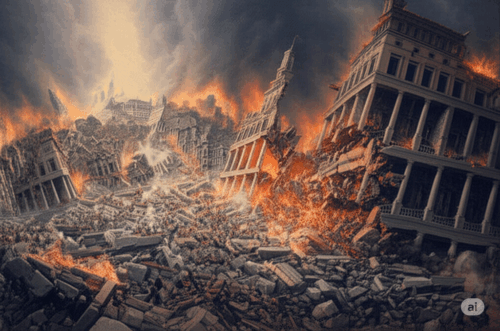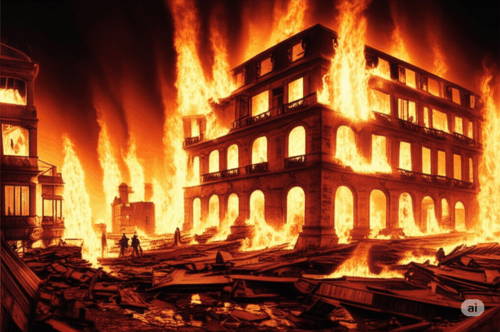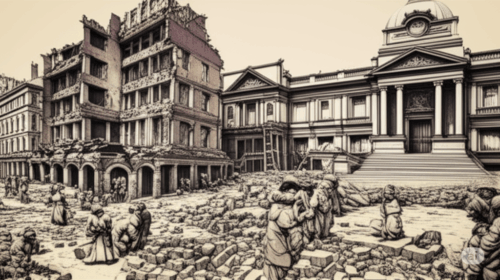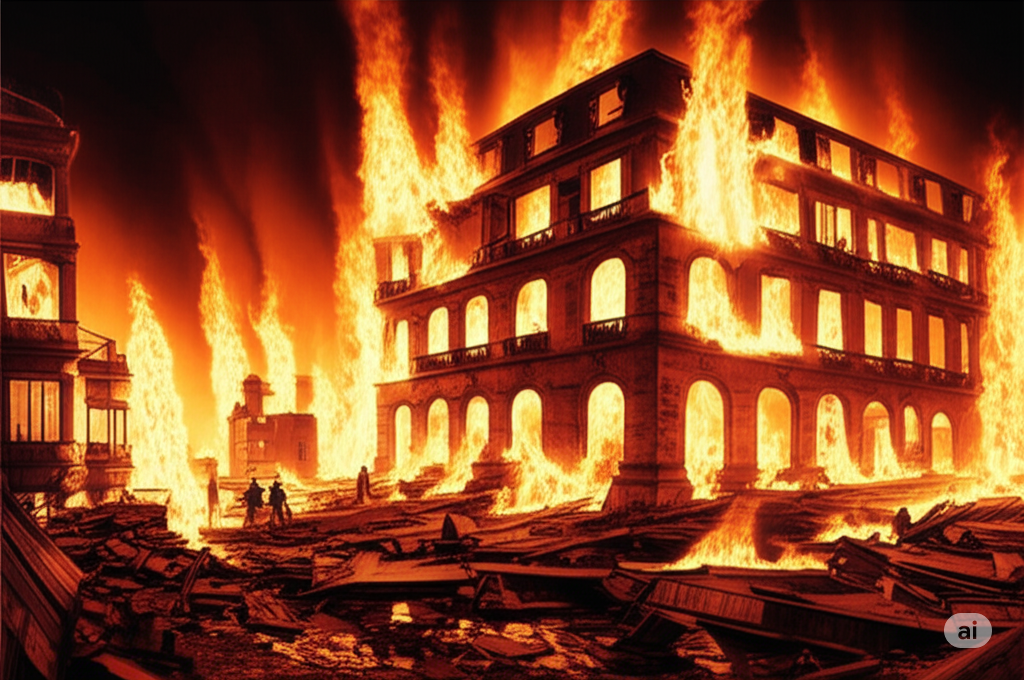Today, as we go about our routines, it’s easy to feel grounded in the present, perhaps with a casual glance towards the future. But history, that vast and often unpredictable ocean of events, constantly whispers lessons to those who listen. On this very date, November 1st, in the year 1755, the vibrant and prosperous city of Lisbon, Portugal, was struck by a catastrophe of unimaginable scale: the Great Lisbon Earthquake.
This wasn’t just a tremor; it was a seismic leviathan that ripped through the earth, followed by a towering tsunami and devastating fires. Within minutes, a jewel of Europe was reduced to rubble and ash, claiming the lives of tens of thousands and shattering the prevailing optimism of the Enlightenment era. Churches, libraries, homes, and the very infrastructure of the city crumbled under the relentless forces of nature.
 The Lisbon Earthquake was more than just a natural disaster; it was a profound shock to the intellectual and spiritual landscape of the time. The sheer scale and seemingly random nature of the destruction challenged existing notions of divine providence and the inherent order of the universe. Philosophers like Voltaire and Kant grappled with its implications, leading to new ways of thinking about the world and humanity’s place within it.
The Lisbon Earthquake was more than just a natural disaster; it was a profound shock to the intellectual and spiritual landscape of the time. The sheer scale and seemingly random nature of the destruction challenged existing notions of divine providence and the inherent order of the universe. Philosophers like Voltaire and Kant grappled with its implications, leading to new ways of thinking about the world and humanity’s place within it.
But amidst the devastation, a remarkable human response emerged. Under the leadership of Sebastião José de Carvalho e Melo, the Marquis of Pombal, Lisbon began a process of methodical rebuilding. This wasn’t just about reconstructing physical structures; it was about implementing new urban planning principles, including wider streets and stronger, earthquake-resistant buildings. Pombal’s vision and decisive action not only led to the rebirth of Lisbon but also laid the groundwork for modern seismology and disaster response.
 So, what does this distant historical event have to do with you, here and now? The story of the Lisbon Earthquake and its aftermath offers profound lessons in resilience, adaptability, and the importance of proactive planning – principles that can be powerfully applied to your individual life today.
So, what does this distant historical event have to do with you, here and now? The story of the Lisbon Earthquake and its aftermath offers profound lessons in resilience, adaptability, and the importance of proactive planning – principles that can be powerfully applied to your individual life today.
The citizens of Lisbon faced a sudden and overwhelming disruption to their lives, much like the unexpected challenges we all encounter – job loss, illness, financial setbacks, or personal crises. Their initial shock and grief were natural, but their subsequent ability to rebuild and reimagine their city provides a compelling model for navigating our own difficulties.
Here’s how you can benefit from the historical fact of the Lisbon Earthquake and apply its lessons to your individual life:
Embracing Resilience in the Face of Disruption:
- Acknowledge and Accept Change: The first step in overcoming any setback is to acknowledge its reality. Like the survivors of the earthquake, recognize that unexpected events are a part of life. Don’t get stuck in denial; accept the new circumstances and prepare to adapt.
- Focus on What You Can Control: In the chaos of the earthquake, individuals who focused on immediate needs like finding shelter, water, and helping others were more likely to survive. Similarly, when facing personal challenges, identify the aspects you can influence and direct your energy there.
- Cultivate Inner Strength: The people of Lisbon drew upon their inner reserves of strength and community spirit to endure the unimaginable. Build your own inner resilience through practices like mindfulness, self-care, and positive self-talk.
- Learn from Setbacks: The rebuilding of Lisbon wasn’t just a return to the past; it incorporated lessons learned from the disaster. When you face challenges, analyze what went wrong and identify opportunities for growth and future preparedness.
 The Power of Proactive Planning:
The Power of Proactive Planning:
- Identify Potential Risks: Just as the people of Lisbon, in hindsight, might have considered the possibility of earthquakes, take time to identify potential risks in your own life – financial instability, health issues, career disruptions.
- Develop Contingency Plans: Pombal’s systematic approach to rebuilding included new building codes and urban planning. Create your own contingency plans for potential challenges. This might involve saving an emergency fund, developing backup career options, or having a plan for unexpected personal situations.
- Build Strong Foundations: The rebuilt Lisbon was designed to be more resilient. In your own life, focus on building strong foundations – nurturing healthy relationships, developing valuable skills, and maintaining your physical and mental well-being. These are your earthquake-resistant structures.
- Seek Knowledge and Information: The scientific inquiry sparked by the Lisbon Earthquake led to advancements in understanding seismic activity. Continuously seek knowledge and information relevant to potential risks in your life. Understand insurance policies, investment strategies, and health guidelines.
 A Specific Plan for Applying These Lessons:
A Specific Plan for Applying These Lessons:
Let’s create a tangible plan to integrate these historical insights into your daily life.
Step 1: Risk Assessment (This Week)
- Bullet Point: Dedicate one hour to brainstorming potential risks in key areas of your life: finances, health, career, relationships, and personal well-being. Be honest and comprehensive.
- Bullet Point: For each identified risk, consider the potential impact and the likelihood of it occurring.
- Bullet Point: Prioritize the top 3-5 risks that have the highest potential impact on your life.
Step 2: Developing Contingency Plans (Next Week)
- Bullet Point: For each of your prioritized risks, brainstorm at least two concrete actions you could take now to mitigate the risk or prepare for its impact. For example, if financial instability is a risk, your actions might include creating a budget and exploring additional income streams.
- Bullet Point: Write down these contingency plans in a clear and actionable way.
- Bullet Point: Identify any resources or support systems you might need to implement these plans (e.g., financial advisor, career counselor, support groups).
Step 3: Building Your Foundations (Ongoing)
- Bullet Point: Dedicate specific time each week to activities that strengthen your foundations. This could include exercise, healthy eating, mindfulness meditation, learning a new skill, or spending quality time with loved ones.
- Bullet Point: Regularly review your risk assessment and contingency plans (e.g., once every quarter) and make adjustments as needed. Life is dynamic, and your plans should be too.
- Bullet Point: Cultivate a mindset of continuous learning and growth. Embrace challenges as opportunities to develop your resilience and adaptability.
Step 4: Embracing Community and Seeking Support (Ongoing)
- Bullet Point: Invest in building strong relationships with family, friends, and your community. These connections can provide crucial support during difficult times, just as the people of Lisbon relied on each other.
- Bullet Point: Don’t hesitate to seek help when you need it. Whether it’s professional advice or emotional support, reaching out is a sign of strength, not weakness.
- Bullet Point: Consider ways you can contribute to your community. Helping others can foster a sense of purpose and strengthen the collective resilience.
 The Great Lisbon Earthquake of 1755 was a stark reminder of the unpredictable nature of life and the fragility of even the most prosperous societies. Yet, it also stands as a testament to the human capacity for resilience, innovation, and the power of proactive planning. By understanding this pivotal moment in history and applying its lessons to our own lives, we can cultivate greater strength, navigate challenges with more confidence, and build our own foundations for a more resilient future. Today, remember Lisbon, and let its story inspire you to prepare for your own inevitable tremors, big or small, and to rebuild stronger than before.
The Great Lisbon Earthquake of 1755 was a stark reminder of the unpredictable nature of life and the fragility of even the most prosperous societies. Yet, it also stands as a testament to the human capacity for resilience, innovation, and the power of proactive planning. By understanding this pivotal moment in history and applying its lessons to our own lives, we can cultivate greater strength, navigate challenges with more confidence, and build our own foundations for a more resilient future. Today, remember Lisbon, and let its story inspire you to prepare for your own inevitable tremors, big or small, and to rebuild stronger than before.

